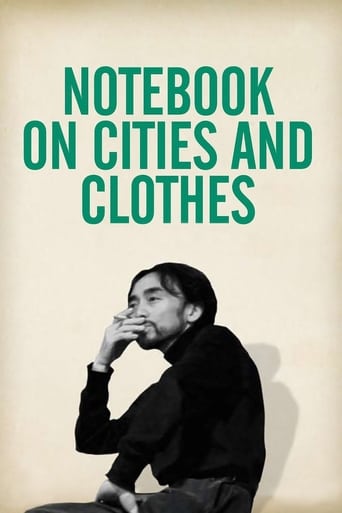JonathanWalford
Although this film starts off with a profoundly interesting voice-over about the nature of inspiration, art, and creativity. The film quickly mires in its own self importance and becomes tiresome. Yohji Yamamoto becomes increasingly incoherent both figuratively, with rambling thoughts about fashion, creativity, and gender, and literally, as his thick accent becomes incomprehensible due to the poor sound quality. Wim Wenders tests several film techniques including split screens, extreme close-ups, and seemingly irrelevant repetitive imagery, which may have been original and interesting in 1989, but are no longer. Worst of all is Wim's monotone voice-overs that become less interesting as the movie progresses. By the end of the hour it becomes difficult to keep your ears and eyelids open. This could have been a fascinating documentary but it's not.
Tim Kidner
I'm more interested in film than fashion and this DVD was part of my ten disc Wim Wenders 'Collection'.Japanese fashion designer Yohji Yamamoto is the focus of this documentary by the German film-maker. He returns to Tokyo, Yamamoto's Tokyo and his fashion studios to see him at work. The thrust of this docu is to be about the Spring fashion show in Paris, in which Yamamoto is taking part.The title 'Notebook On Cities & Clothes' is so called as Wim always sees far beyond the periphery of what is ordinary, what most people see. This is what makes him and his docu's so fascinating. Both he and Yamamoto compare cities, how cities can be nation-less, "I don't feel Japanese, I feel I'm a Tokyo-ite" says Yohji. Natural comparisons between Paris and Tokyo get discussed too.Wenders' is never afraid to try new techniques to supplement his visual palette and here he found (this is 1989) that filming the designer at work with normal 35mm film was both intrusive and cumbersome, whereas video was not. The downside, at least then, was the quality, though he's keen to agree but is sure which direction both the industry and his work is going, equipment wise.Wim will show and run up to two or three small actual TV screens within the main one, showing a general scene, one with the person narrating and another showing that same person working. It never looks too cluttered and without the computers of today must have made syncing them quite tricky.Yamamoto is happy to chat and philosophise on camera. He seems most at ease leafing through books of old black & white photos of Japanese working people and their practical, working clothing, their faces and body language telling their stories, not the garments they wear. He'll then later compare the Japan of today (well, 1989) thinking that anything it wants and chooses can be simply bought.If you're a big fan of Yamamoto, or Wenders, you'll give it a higher score than I did. It's naturally dated but remains interesting, rather than riveting viewing.
carll-2
Wenders have succeeded in turning an assignment he got by the Pompidou centre into a work that's actually rather fascinating. It's a really fresh essay film. It doesn't tell so much about it's subject the fashion designer, but reflects on more abstract issues like art and fashion, and time and timelessness, and subjectivity and objectivity.Although I felt it was very beautiful and fascinating, I thought that it maybe lacked in urgency somewhat - the fashion designer and all the persons in the film remained really distant. But at the same time I found it fresher and not so over-elaborated as some of Wenders movies. For friends of essay-movies and the late movies of Godard it's highly recommended.
Firas
I can't say much about the movie. It is principally interesting because it shows the similarity of the creativity of two artists (a fashion designer and a film director) with the emphasis on the first one. It is in fact a creative documentary about the two of them. There was also an attempt to define fashion and identity in our modern world. It is a typical Wim Wenders movie. The photography is marked by his style. This movie or documentary becomes sometimes boring. The emphasis on the differences between the movie camera and the video camera was interesting but it was often tiring


